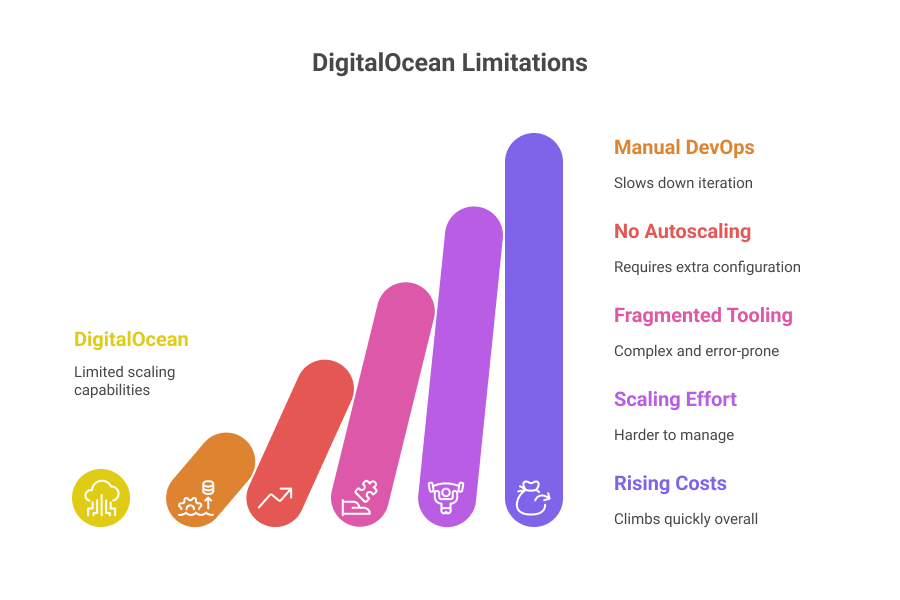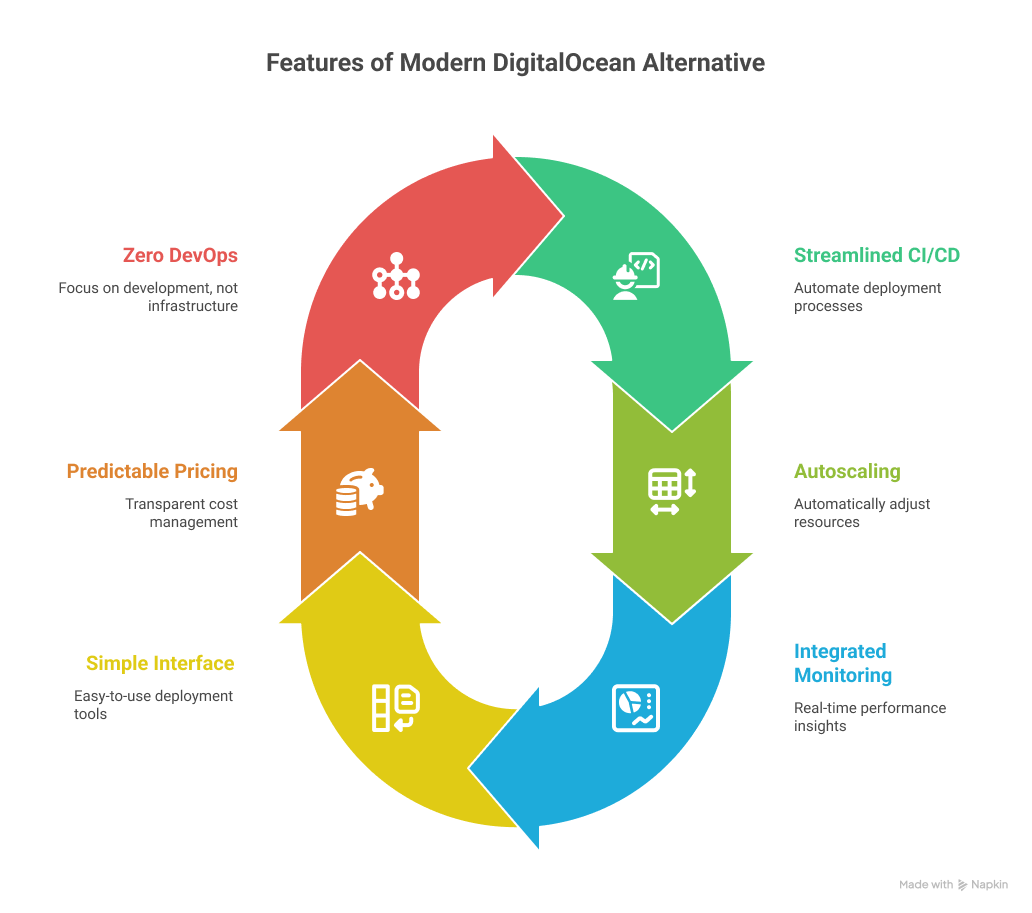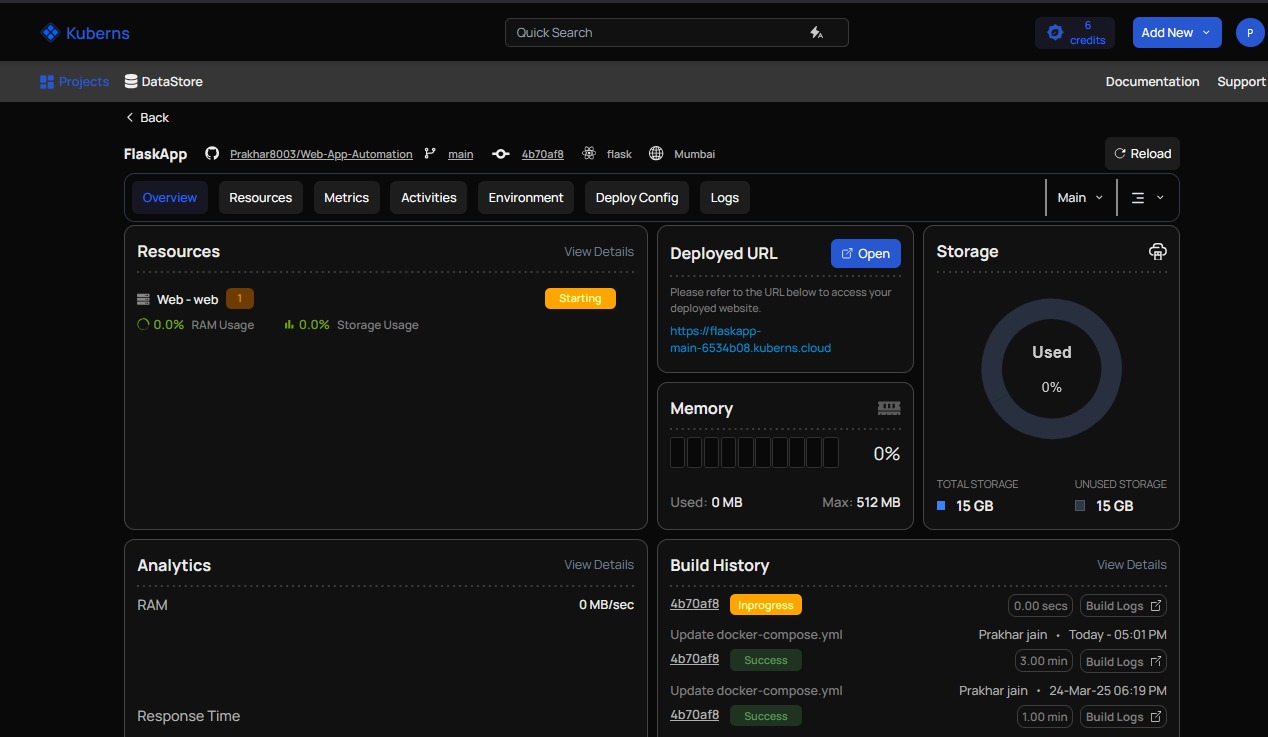Published
- 8 min read
Best DigitalOcean Alternative for Solo Developers & Startups in 2025

DigitalOcean is a widely used cloud hosting platform that offers virtual machines, known as Droplets, along with a straightforward dashboard and developer-friendly APIs. It gained popularity among solo developers, indie hackers, and early-stage startups for one key reason, simplicity. With its predictable pricing and fast setup, it has often been the go-to choice for deploying small applications without a steep learning curve.
However, in 2025, the expectations from cloud platforms have shifted. Developers no longer just want virtual machines, they need end-to-end solutions. Built-in CI/CD pipelines, autoscaling, performance monitoring, and zero-config deployments are becoming baseline requirements, not premium features. While DigitalOcean’s App Platform attempts to bridge some of these gaps, it still lacks the depth and automation that modern teams require.
For developers building production apps, managing infrastructure manually quickly becomes a bottleneck. If you’re starting to feel limited by VPS and container basics, it may be time to explore platforms designed for modern app lifecycles. Here’s a breakdown of the best DigitalOcean alternatives for modern app deployment to help you compare what’s available.
Why Are Solo Developers and Startups Leaving DigitalOcean in 2025?
 While DigitalOcean continues to be a reliable starting point for hosting, many developers and startups begin to hit limitations as their applications scale. What starts as a lightweight and flexible VPS often turns into a growing maintenance burden.
While DigitalOcean continues to be a reliable starting point for hosting, many developers and startups begin to hit limitations as their applications scale. What starts as a lightweight and flexible VPS often turns into a growing maintenance burden.
Here are some of the most common reasons developers move on from DigitalOcean:
- Manual DevOps setup: Configuring Nginx, Docker, CI/CD pipelines, SSL, logging, and alerts must be done separately, which slows down iteration.
- No native autoscaling: Droplets do not scale automatically based on traffic, and adding autoscaling requires extra tools and configuration.
- Fragmented tooling: Developers often rely on third-party services for logs, metrics, deployments, and monitoring, leading to a more complex and error-prone stack.
- Scaling requires effort: As applications grow, infrastructure becomes harder to manage, and development velocity suffers.
- Rising total cost of ownership: Initial pricing may be low, but when you factor in engineering time, DevOps tooling, and external services, the overall cost climbs quickly.
If you are starting to feel these pain points, it may be worth considering platforms that offer more out of the box. You can explore this comparison of the best DigitalOcean competitors to see how modern alternatives reduce complexity and save time.
What Should You Look for in a DigitalOcean Alternative?
 As cloud platforms evolve, so do developer expectations. If you’re actively searching for a DigitalOcean alternative in 2025, you’re likely looking for something more streamlined, scalable, and easier to manage.
As cloud platforms evolve, so do developer expectations. If you’re actively searching for a DigitalOcean alternative in 2025, you’re likely looking for something more streamlined, scalable, and easier to manage.
The right platform should offer:
- Built-in CI/CD pipelines that require no YAML or manual scripting
- Autoscaling that works automatically, without setting up load balancers or custom policies
- Monitoring and alerting tools already integrated, so you do not have to rely on external services
- A clean, simple interface with one-click deployments and Git-based workflows
- Predictable pricing that fits startup budgets, with no hidden usage spikes
- Zero DevOps requirement, so teams can deploy without maintaining infrastructure
These features are no longer nice to have. They are essential for developers and startups that want to move quickly without the overhead of managing servers or third-party integrations.
If you’re unsure how to evaluate all these aspects, this guide to choosing the right CI/CD tool for your project breaks down what modern teams actually need from their deployment stack.
Kuberns brings all of this together in one place, helping developers ship faster without worrying about setup, scaling, or platform complexity.
What Is the Best DigitalOcean Alternative in 2025?
For solo developers and startups looking to move beyond manual infrastructure, the best DigitalOcean alternative in 2025 is Kuberns.
Kuberns is a fully managed, AI-powered platform that simplifies the entire deployment lifecycle. It allows developers to go from Git to production in just a few clicks, without writing custom scripts or configuring servers. The platform is designed to remove the technical and operational complexity that typically comes with deploying and scaling modern applications.
Instead of setting up separate services for CI/CD, monitoring, scaling, and logs, Kuberns bundles everything into a single interface that works out of the box. This makes it especially well suited for solo developers, indie hackers, and fast-moving SaaS teams that need to launch quickly and iterate often.
Kuberns is not just a hosting platform, it is a complete developer experience designed for modern app delivery. If you’re looking for an alternative that saves time, reduces tooling overhead, and lets you focus entirely on product development, Kuberns checks all the boxes.
How Does Kuberns Compare to DigitalOcean?
| Feature | DigitalOcean | Kuberns |
|---|---|---|
| VPS/Droplets | Yes | Fully managed |
| DevOps setup needed | Yes | No |
| Built-in CI/CD | Partial (App Platform) | Yes |
| Autoscaling | Not native | Yes (AI-based) |
| Monitoring and Alerts | External tools | Built-in |
| Ideal for solo developers | No | Yes |
Is It Easy to Migrate From DigitalOcean to Kuberns?
 Yes, migrating from DigitalOcean to Kuberns is straightforward and does not require any changes to your tech stack. You can continue using the same languages, frameworks, and databases, while gaining access to a fully managed deployment experience.
Yes, migrating from DigitalOcean to Kuberns is straightforward and does not require any changes to your tech stack. You can continue using the same languages, frameworks, and databases, while gaining access to a fully managed deployment experience.
Kuberns is built to eliminate the manual setup typically involved in moving applications between platforms. There is no need to write infrastructure scripts, configure DNS manually, or install separate monitoring tools. The platform handles all the heavy lifting behind the scenes.
Here is how the migration process works:
- Connect your GitHub or GitLab repository to sync your application code
- Choose a preconfigured environment or bring your own container image
- Click deploy to launch your app on Kuberns infrastructure
Once deployed, Kuberns automatically provisions resources, assigns custom domains, enables HTTPS with SSL, sets up real-time logging, configures environment variables, and handles autoscaling based on load.
The entire process can be completed in minutes, even for production apps. If you want to understand how this works behind the scenes, you can explore this guide on how to implement one-click automated software deployment.
Why Is Kuberns Ideal for Solo Developers and Startups?
 Kuberns is purpose-built for developers and teams who want to build and deploy applications quickly without getting caught up in infrastructure complexity. Whether you’re an indie developer launching your first product, a freelancer managing client projects, or a startup preparing for scale, Kuberns provides the tools to move fast and stay focused on what matters most, your application.
Kuberns is purpose-built for developers and teams who want to build and deploy applications quickly without getting caught up in infrastructure complexity. Whether you’re an indie developer launching your first product, a freelancer managing client projects, or a startup preparing for scale, Kuberns provides the tools to move fast and stay focused on what matters most, your application.
Unlike traditional cloud platforms that require separate services and manual configuration, Kuberns consolidates the entire deployment stack into a single, fully managed platform. This eliminates the need for DevOps expertise and reduces the overhead of maintaining multiple tools.
Kuberns effectively replaces five or more services that solo developers and startups often struggle to manage:
- CI/CD pipelines such as GitHub Actions or Jenkins
- Infrastructure providers like AWS or DigitalOcean
- Monitoring and alerting tools such as Datadog or Grafana
- SSL and DNS configuration, typically done manually
- Container hosting or orchestration, without requiring Kubernetes knowledge
This level of integration is especially valuable for teams without a dedicated DevOps engineer. It means faster setup, fewer bugs caused by misconfigurations, and more time to focus on shipping features and engaging users.
If you’re deciding between different cloud platforms, you can see how Kuberns compares in Heroku vs DigitalOcean and Heroku vs Kubernetes vs Kuberns, both of which offer detailed breakdowns of platform capabilities, costs, and developer experience.
Kuberns was built for developers who want to ship fast without becoming DevOps experts. It is used by indie developers, agencies, and seed-stage startups to save time, reduce costs, and move faster from prototype to production.
Should I Switch From DigitalOcean to Kuberns?
DigitalOcean works well at the beginning, but scaling often brings hidden complexity. If you’re spending more time managing servers than building your app, it may be time to switch.
Kuberns gives solo developers and startups everything they need to deploy fast, scale automatically, and skip DevOps setup. With built-in CI/CD, monitoring, and autoscaling, it replaces the need for multiple tools and manual configuration.

Frequently Asked Questions
1. What is the best DigitalOcean alternative for startups?
A: Kuberns is purpose-built for startups that want bundled CI/CD, autoscaling, and monitoring without having to configure infrastructure manually.
2. Is Kuberns cheaper than DigitalOcean?
A: Yes, Kuberns replaces multiple services and automates your stack, reducing your total cost of ownership significantly.
3. Can I migrate from DigitalOcean to Kuberns easily?
A: Yes, you can deploy your app from GitHub in minutes without rewriting configs or provisioning servers.
4. Do I need DevOps experience to use Kuberns?
A: No, Kuberns handles deployment, scaling, monitoring, and alerts automatically, making it ideal for developers who want to focus on code, not infrastructure.